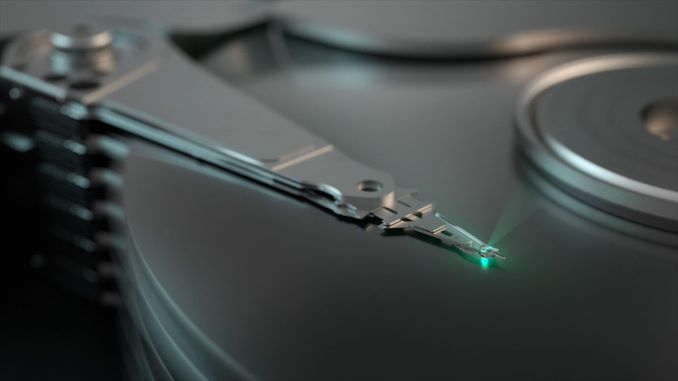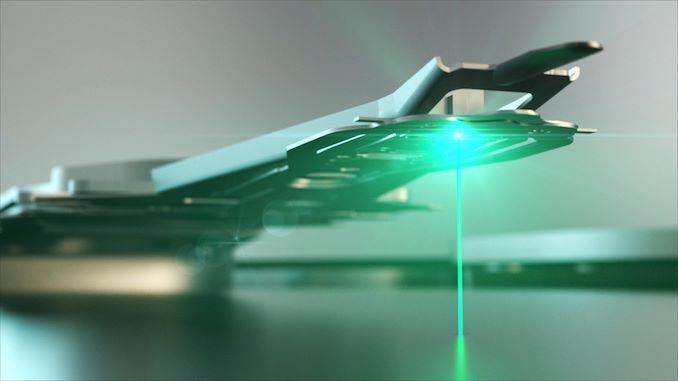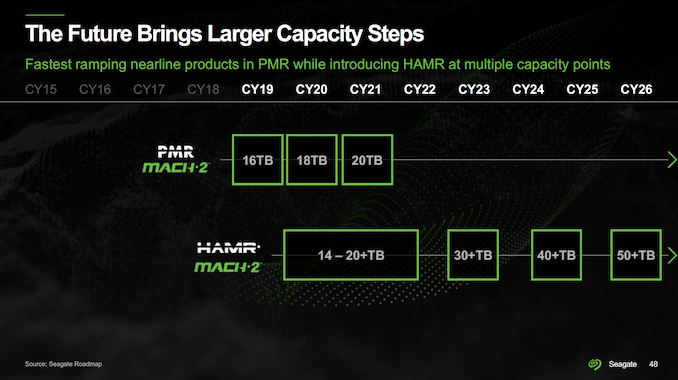Seagate Confirms 30TB+ HAMR HDDs in Q3, Envisions 50TB Drives in a Few Years
by Anton Shilov on January 27, 2023 6:00 PM EST
Seagate this week confirmed plans to launch the industry's first 30+ TB hard drive that uses its heat assisted magnetic recording (HAMR) technology, as well as reaffirming its commitment to release HDDs with capacities of 50 TB and higher in a few years. But before this happens, the company will release 22 TB and 24 TB HDDs that will rely on perpendicular magnetic recording (PMR) and shingled magnetic recording (SMR) technologies, respectively.
One More Play for PMR and SMR
Various energy assisted magnetic recording methods, such as HAMR, will be used for next generations of hard drives for years to come. But while PMR is running out of steam, it is still evolving. Seagate has managed to increase areal density enabled by its PMR + TDMR platform by around 10%, enabling 2.2 TB 3.5-inch HDD platters and thus 22 TB hard drives featuring 10 of such disks. Furthermore, by using shingled recording, these drives can have their capacity stretched to 24 TB.
These 22 TB and 24 TB Seagate Exos drives will likely be drop-in compatible with existing cloud datacenter hardware as well as infrastructure, and should not require extensive validation and certification procedures, unlike brand-new HAMR HDDs. As a result, Seagate's customers will be able to deploy such hard drives fairly quickly and increase storage density and storage capacity of their datacenters.
Seagate is now ramping up production of its 22 TB hard drives for datacenters, so expect the company to start their shipments shortly. Seagate is not disclosing when exactly it will officially launch its 22 TB and 24 TB parts, but we would expect them to arrive before the company introduces its HAMR-based HDDs; so think Q1 or Q2.
30+ TB HDDs Coming in Q3
In fact, Seagate has been shipping HAMR HDDs to select customers for evaluation as well as inside its own Lyve storage systems for a while, but those drives featured capacities akin to those of PMR/CMR HDDs and were not available in huge volumes. With Seagate's 2nd generation HAMR platform, the company is going after higher volumes, but it took the company quite some time to get there. The first pre-qualification high-capacity HAMR-based HDDs are only just now getting ready to head out to customers for evaluation.
"We are meeting or exceeding all product development milestones and reliability metrics, and we will be shipping pre-qualification units to key cloud customers in the coming weeks," said Dave Mosley, chief executive of Seagate.
Meanwhile, commercial HAMR hard drives with capacities of 30TB or higher will ship in third quarter of this year, which is in-line with what Seagate promised last year.
"As a result of this progress, we now expect to launch our 30-plus terabyte platform in the June quarter, slightly ahead of schedule," said Mosley. "The speed of the initial HAMR volume ramp will depend on a number of factors, including product yields and customer qualification timelines."
Initially Seagate will only offer its HAMR technology for its highest-capacity offerings for hyperscale datacenters, whom need maximum storage density and are willing to pay premium for the drives and for supporting infrastructure. As yields of HAMR-supporting media and the appropriate read/write heads increase, the technology will be applied for drives with lower capacities in a bid to cut down their production costs (fewer disks and heads, lower the costs). This is not going to happen overnight though, as the company needs to increase yields of HAMR drive components and the HDDs themselves to a comfortable level.
"I think this year, [the volume of HAMR HDDs] will probably still be relatively low," said the head of Seagate. "Then the faster we can get the yields and scrap and all the costs that we can control down on the heads and media, then the faster we'll be accelerating. I think that will happen in calendar year 2024 and calendar year 2025 will just continue to accelerate. The highest capacity points will be addressed, but also these midrange capacity points."
50+ TB HDDs Will Be Here in a Few Years
Seagate's launch of its first mass market 30+ TB HAMR hard drives platform will mark a milestone for the company and the whole industry. But apparently the company has another breakthrough to share at this time. The firm said this week that it had created 5 TB platters for 3.5-inch hard drives, which presumably entails new media, new write heads, and new read heads.
"It was nearly four years ago to the day that I first shared our lab results demonstrating 3 TB per disk capacities," explained Mosley. "And today, we have demonstrated capacities of 5 TB per disk in our recording physics labs."
For now, these platters are used on spinstands for evaluation and testing purposes, but platters like these will allow for 50 TB HDDs a few years down the line. Seagate's roadmap indicates that such hard drives will hit the market sometimes in calendar 2026.
It is unclear how thin the new platters are. But following current trends of nearline HDD evolution — increasing areal density and increasing number of platters per hard drive — it's not outside the realm of possibility that Seagate will find ways to integrate even more than 10 platters in future drives. In which case Seagate would be able to hit drive sizes even larger than 50 TB.
In any case, with ~3 TB platters in production, samples of ~30 TB HDDs shipping to customers, and 5 TB platters demonstrated in the lab, Seagate's HAMR roadmap seems to look quite solid. Therefore, expect hard drives to gain capacities rapidly in the coming years.












70 Comments
View All Comments
DanNeely - Monday, January 30, 2023 - link
TB/rack is something big cloud/etc operators care about. The amount of data they need to handle is growing exponentially, and upgrading to new denser HDDs is cheaper than building new data centers.Doug_S - Monday, January 30, 2023 - link
They are limited by power long before they are limited by the difference between HDD and SSD.Marko123 - Monday, January 30, 2023 - link
That's true but it's a distant third to $/GB and power consumption (i.e. TCO).Reflex - Monday, January 30, 2023 - link
Right now there is no path for NAND to catch up to HDD's in the same physical space or price. That said, there are other competitors for solid state storage, as well as other takes on flash memory that could pose a challenge. I was hoping Optane would be it, but unfortunately it's just not able to be produced cheap enough at high density yet.Samus - Sunday, January 29, 2023 - link
Von,Hard drives have numerous advantages over solid state drives. The storage industry isn't purely focused on 'speed' as a performance metric.
Hard drives have superior archival performance as noted by Stevo. NAND will fade long before hard disks will - I have magnetic disks that are decades old with no data retention problem, and many have no bad sectors.
Hard drives have superior reliability in heavy non-WORM applications. SSD's have a finite lifetime of writes - HDD's don't. This makes hard disks the continued standard for databases and backup\archive.
As you mentioned, hard disks are less expensive per TB, but keep in mind most non-consumer (think enterprise\data center) clients are less sensitive to cost and more sensitive to reliability and low maintenance.
Even if solid state cost per TB were identical to hard drives, you would still see the later continue being used in a variety of large-scale applications. Magnetic storage isn't going anywhere until NAND has similar data retention and write amplification properties.
As far as helium drives, there as specific metrics for proper storage that if not followed will cause the seal to fail. It's important they be kept above 30C - even when cold. Temperature fluctuations are the primary cause of helioseal failures in WDC\Hitachi drives. Seagate has a different seal technology that seems to be more resilient during cold storage.
qap - Sunday, January 29, 2023 - link
You can't compare decades old HDDs with current. Physical size of a bit has decreased significantly and that leads to shorter time it stays readable.Hard drives have limited write endurance as well. It mostly relates to spin-up/spin-down cycles, but recently HDD manufacturers started listing also DWPD metric and is not great.
As for large scale storage - it's not as easy as you think it is. We have large storage (in PBs) and it can actually be cheaper to store it using SSDs. We can use less of them because we can use erasure codes instead of mirroring in our object storage thanks to much faster access times and higher iops.
And one thing about cold storage - our experience is that you really don't want to use HDDs for that. When you turn them off, there's good chance that some of them will not spin up when you turn the server on in a month (or even in one day if you have to move servers elsewhere). SSDs don't have this problem.
What will eventually kill HDDs is their speed. Or to be more precise speed-to-capacity ratio. Even already existing 20TB HDD takes several days to recover (failures are inevitable in a large scale storage). That's a f***ing huge window for another drive, two or even more to die. And unfortunately it's intrinsical for HDDs that their speed grows with square root of their capacity (it doesn't grow with number of tracks, only with density of data per track). Replacing a failed 30+TB HDD would really take a week. Even two mirrors are not enough in that scenario.
Marko123 - Monday, January 30, 2023 - link
PBs is not really large storage, compared to CSP deployments where 100K+ drives will be aggregated in a large data center. And these cloud HDDs run flat out 24/7 for their life and never get rebuilt - large ECC codes are used. Rebuild doesn't make sense for the reasons you say - that is why storage arrays have mostly moved to SSDs. The increase in storage device cost/GB (~7x) isn't material relative to other costs and the benefits. HDDs will not die, there is too big a cost gap to solid state. In essence, a HDD uses a very expensive small solid state device (the head) and multiplies up the storage capacity by spinning cheap media under it. It's also not obvious to me that these HAMR drives will ever be sold to non-cloud customers.UltraTech79 - Monday, January 30, 2023 - link
"Hard drives have superior archival performance"WRONG. People like you pulling data out of your ass need to stop posting.
https://www.backblaze.com/blog/are-ssds-really-mor...
Even worse case for SSD they are roughly equivelent.
Maltz - Monday, January 30, 2023 - link
That article is about failure rates of drives in active use. It says nothing at all about long-term data integrity in offline ("archival") storage.I think it's a pretty commonly accepted thing that NAND voltage levels fade over time when the drive isn't powered and able to refresh them, especially in higher-density technologies like TLC, QLC and up. Samsung actually had an SSD firmware issue several years ago that illustrated this, causing data corruption in a matter of a year or so because it failed to refresh faded cells often enough. Magnetic HDD storage will also eventually fade, of course, but my understanding is that it takes a LOT longer. I suspect that's still true even in newer, denser HDD media, even if the newer drives might not be as robust as older drives in that respect.
Reflex - Monday, January 30, 2023 - link
The number of people who misconstrue Backblaze data to make a case for their favorite brand/medium/method never ceases to amaze me. Like you said, they were measuring something entirely different than what was being discussed.